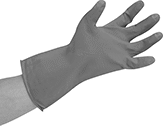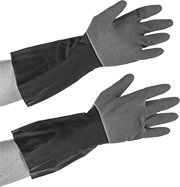About Glove Sizing
More
Acid-Resistant Gloves

Often used for cleaning lab spaces, these gloves withstand most acids, alcohols, and cleaning solutions. They also resist abrasion and offer good dexterity.
Food-service gloves are made of FDA listed materials for use with food.
Textured gloves provide a better grip than smooth gloves.
Gloves without a lining offer the best dexterity.
Chemical-Resistant Sleeves

Use these sleeves alone or with gloves to protect your arm from oils and most acids.
PVC-coated polyester sleeves provide some chemical and acid resistance. They also protect your arm from abrasive material.
| Coating Material | Coating Coverage | Thick., mil | Lg. | Cuff Style | Color | Size | Pair | |
Polyester Fabric | ||||||||
|---|---|---|---|---|---|---|---|---|
| PVC Plastic | Full | 17 | 18" | Elastic | Green | One Size | 0000000 | 000000 |
Acid- and Heat-Protection Gloves

The lining withstands intermittent heat, while the outer layer of material acts as a barrier to chemicals and solvents. All of these gloves are textured on the fingers and palm for added grip.

























